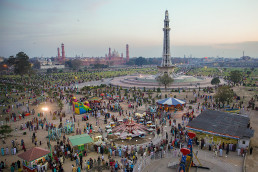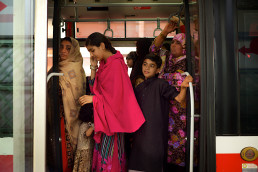Part of the ADB 100 Climate Actions from Cities across Asia
“It was the best of times. It was the worst of times.” Affluence and urban services. Climate change and COVID-19. It is against this backdrop that Sustainia and the Asian Development Bank (ADB) examine not two, but one hundred cities grappling with the challenges of urban development in the most uncertain of times. In the newly released publication, 100 Climate Actions from Cities in Asia and the Pacific, we highlight cities that all share one common desire: to take climate action.
Asia has a kaleidoscope of climate challenges
Stretching from the pristine Pacific Island beaches, to Chinese coastal cities, monsoon-prone Bangladeshi megacities, to the mongolian Steppe and Himalayan cities in the sky, Asia’s geography is enormously varied. And so are the challenges that come with climate change to each of these cities. The municipal level is where the amorphous, global nature of climate change is finally translated into the tangible, life-threatening reality for local citizens. Dry cities could become drier, exposing more people to water shortages, sea-level rise will imperil low-lying islands and more intense storms will impact coastal cities.
To compound these climatic challenges, Asian cities are also some of the fastest growing cities in the world. The unprecedented speed and scale of Asia’s urbanisation has created challenges for infrastructure development and urban services, particularly for urban waste, sanitation, and pollution. Climate change will only act as a threat multiplier for these challenges, exacerbating pre-existing urban problems. Poor sanitation combined with high flood risk in a densely populated city like Ho Chi Minh, for example, is a potent combination, where waterborne diseases are more likely to spread following a flooding event.

Turning climate risks into urban opportunities
Despite these grave and pressing challenges, the cities highlighted in this publication have chosen to take a risk-to-opportunity mindset. Sustainable urban development has the potential to integrate benefits for communities and the environment, meaning people will be supplied with the goods and services they need alongside efforts to adapt to and mitigate climate change. Although many of the goals and targets associated with climate action have global implications, they often require local action, which is why cities have never been more important.
Many of the cities highlighted in this report are taking their first steps towards building resilience and/or reducing their emissions, which is truly exciting. From the construction of the nation’s first utility-scale solar plant in Afghanistan to a project piloting water-sensitive intervention in Indonesia, more countries than ever before are choosing to get involved. Even countries like Micronesia with miniscule emissions contributions are making mitigation efforts a priority, recognising both its importance for future survival and the social, economic, and environmental co-benefits that accompany climate action.
Climate change has unequally distributed impacts
Cities described in this report are also increasingly acknowledging that the effects of climate change are often unequally distributed, with the most vulnerable members of society taking the brunt of the impact. Citizen engagement, holistic solutions, and the inclusion of marginalised voices are all ways that climate action can uplift society as a whole. At the city level, it is possible to see how abstract objectives can result in material action, and thus have a concrete impact on the everyday lives of people who are living on the frontline of climate change.
Furthermore, inequality is often a marked characteristic of urban growth, with access to urban services, land, and economic opportunities varying largely within cities. For certain groups, like women, marginalised communities, and those living in informal settlements, new urban planning schemes that address climate change have the potential to not only increase their resilience, but may also help them realise some of the economic and social benefits commonly associated with urbanisation.

Megacities are not the only focus for climate action
Although megacities receive a lot of attention, the majority of urban residents actually live in rapidly expanding small and medium-sized cities which do not have the same resources to take climate action as larger urban centres. This report shows prime examples of where smaller cities have identified public infrastructure development as a strategic priority for improving the ability of residents to adapt effectively to climate change.
An impressive assortment of options for cities
Given the variability and unique position of cities in Asia and Oceania, covering the Kazakh steppe to the shores of Fiji, the breadth and variety of climate solutions found in this region should come as no surprise. Renewable energy, innovative financing, cleaner transportation, transformative land use schemes, smart tools, resilience measures, low-carbon developments, ambitious action plans, increased building efficiency, and improved waste management are just some of the initiatives cities are implementing to move away from a reliance on fossil fuels and lower greenhouse gas emissions.
Moreover, the answers to climate change do not only lie with cutting edge technology, but also on straightforward solutions, like the planting of one billion trees in Pakistan, or replacing traditional stoves with clean-burning cookstoves in Afghanistan.
With growing populations that will continue to expand, cities need to find a way to meet the needs of residents with effective energy, transportation, sanitation, and water infrastructure, while also ensuring that these developments do not come at the expense of the environment. By building a strong foundation and commitment to progressive climate action, they can help spread the wave of the green movement globally.
COVID-19: a twist in the tale
Not even Dickens could have written a plot twist like this. Cities and countries all over the world are now facing unprecedented challenges associated with the global pandemic, and all are being forced to re-think even more closely how to build societies going forward. This is a great opportunity for local governments to build back better, by investing in a greener and more resilient future. No one knows how this tale of cities will end, but one thing is for sure, this real-world epic will be one for the ages.